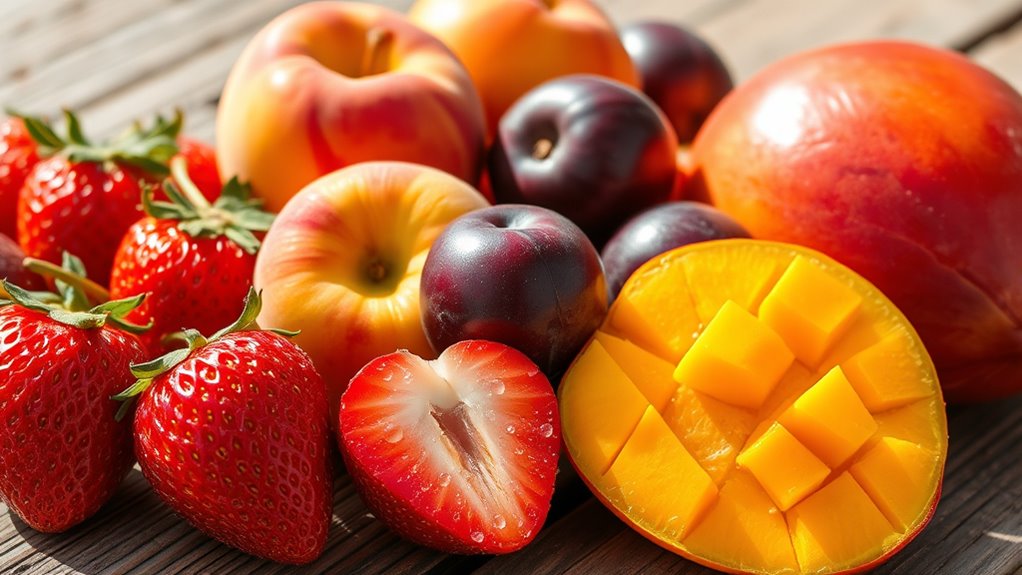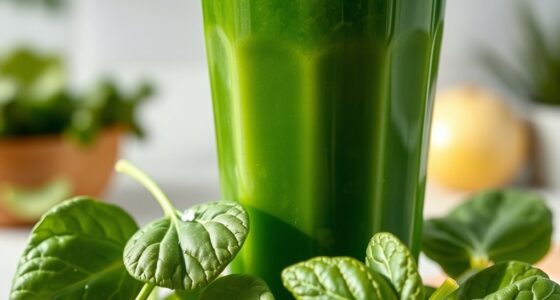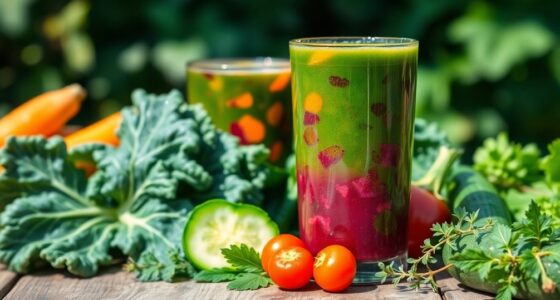When comparing natural sugars in summer fruits, you’ll find watermelon is hydrating and mildly sweet, while mangoes pack more complex sugars that develop as they ripen. Cherries and grapes have high sugar concentrations that boost energy and flavor, with blueberries offering antioxidants alongside subtle sweetness. Peaches and apricots are juicy with gentle sugar levels, and pineapples balance tartness with rich sugars. Continue exploring to discover how ripeness and storage influence their sweetness and health benefits.
Key Takeaways
- Watermelon has high water content with moderate natural sugars, mainly glucose and fructose, providing hydration and subtle sweetness.
- Mangoes contain complex sugars that increase during ripening, with glucose, fructose, and sucrose contributing to their rich flavor.
- Cherries and stone fruits like peaches and plums develop higher sugar levels as they ripen, primarily glucose and fructose, enhancing sweetness.
- Pineapples have a balanced mix of sucrose, fructose, and glucose, with sugar levels rising as they fully ripen, producing a sweeter taste.
- Berries like strawberries and blueberries are lower in sugar but rich in antioxidants, with natural sugars mainly fructose and glucose, offering subtle sweetness.
Watermelon: Hydrating and Sweet
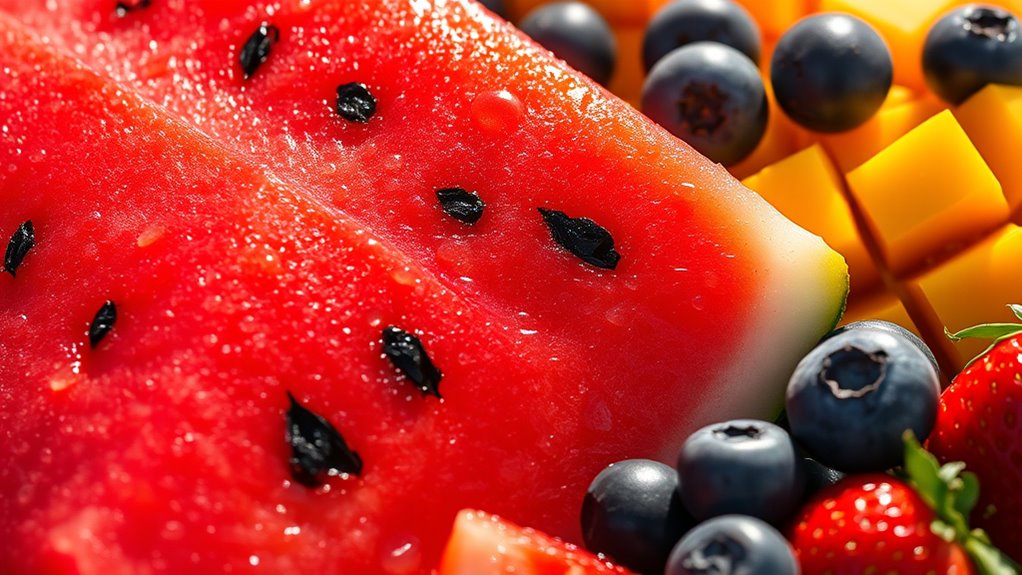
Watermelon is a popular summer fruit known for its high water content and natural sweetness. Its hydration benefits are unmatched, making it an ideal snack on hot days. As you bite into it, you’ll notice its invigorating juiciness helps keep you hydrated and energized. The flavor profiles of watermelon are subtly sweet with a hint of earthiness, which appeals to many palates. Its crisp texture and juicy feel make it a satisfying choice during warm weather. Whether eaten on its own or added to fruit salads, watermelon provides a delicious way to quench your thirst while enjoying the fruit’s natural sugars. Its balance of sweetness and water content makes it an essential staple for summer hydration and flavor. Additionally, the natural sugars in watermelon can support sugar regulation when consumed as part of a balanced diet. To maintain optimal freshness, proper storage conditions are crucial to preserve its texture and flavor.
Mangoes: Tropical Richness and Sugar Content
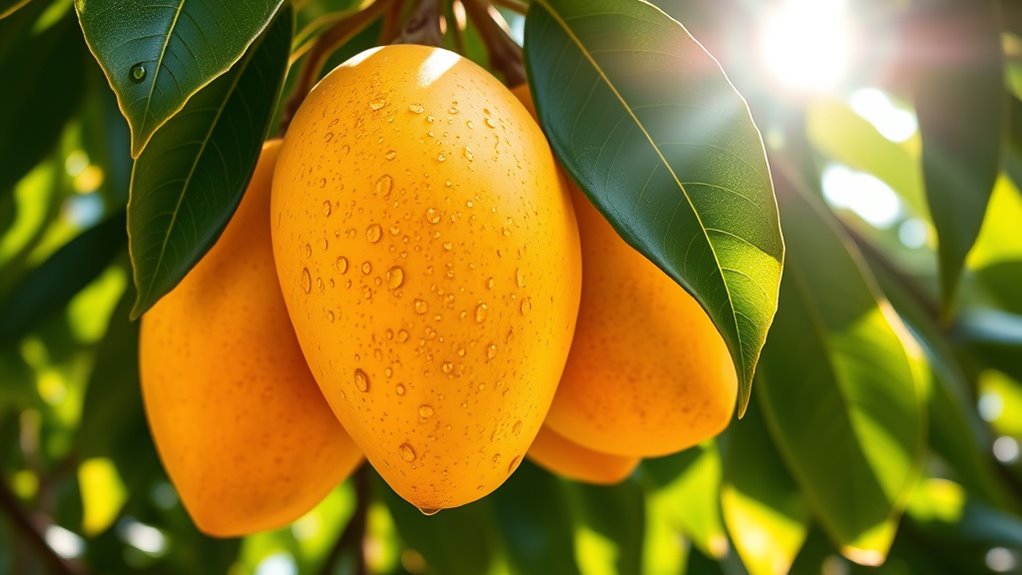
Mangoes pack a sweet punch thanks to their natural sugars, which vary depending on the variety and ripeness. Besides their delicious taste, mangoes offer health benefits like vitamins and antioxidants that support your wellness. To enjoy them best, try slicing fresh mangoes or adding them to your favorite summer dishes for a burst of flavor. Incorporating mindful eating practices can enhance your appreciation of their natural sweetness and promote better digestion mindfulness techniques.
Mango Sugar Composition
Have you ever wondered what makes summer fruits like mangoes so irresistibly sweet? The answer lies in their sugar composition, which develops during mango ripening. As the fruit matures, natural starches convert into simple sugars like glucose, fructose, and sucrose, enhancing sweetness. During this process, sugar crystallization occurs, creating a smooth, juicy texture that signals peak ripeness. The balance of these sugars varies depending on the mango variety and ripening conditions, influencing flavor and sweetness levels. When you bite into a perfectly ripened mango, you’re experiencing the culmination of these biochemical changes. Understanding mango sugar composition helps explain its luscious taste and why ripe mangoes are so universally loved. This natural sugar buildup is a key factor in mangoes’ tropical appeal. Additionally, the ripening process is crucial in determining the final sugar content and overall flavor profile of the fruit, with factors like temperature and storage conditions playing significant roles in sugar development. Moreover, the composition of natural sugars varies across different fruits, contributing to their unique flavors and textures, and the enzymatic conversion during ripening significantly influences the sweetness levels.
Health Benefits of Mangoes
The natural sugars that develop in mangoes not only contribute to their irresistible sweetness but also offer several health benefits. These sugars provide a quick energy source, making mangoes a great snack during active days. Due to mango cultivation across tropical regions, many mango varieties exist, each with unique nutritional profiles. Eating mangoes can boost your immune system thanks to their high vitamin C content and promote healthy digestion with fiber. Additionally, they contain antioxidants that help combat oxidative stress. The variety you choose may influence the level of sugars and nutrients, but all mangoes support hydration and skin health. Incorporating different mango varieties into your diet allows you to enjoy their sweet flavor while reaping their health benefits. Glycolic acid is also used in skincare to exfoliate and improve skin texture, highlighting the importance of choosing healthy ingredients in your diet and personal care. Understanding sugar content in summer fruits can help you make better dietary choices to maintain overall health. Recognizing the nutritional differences among mango varieties can help optimize your health benefits. Additionally, awareness of natural sugars and their effects can guide you toward balanced consumption for overall well-being. Furthermore, research into sound healing science reveals how natural elements like fruit sugars can influence overall health and vitality.
Tips for Enjoying Mangoes
To fully enjoy mangoes’ tropical richness and natural sweetness, it’s best to choose ripe, fragrant fruits that feel slightly soft when gently pressed. Look for vibrant color and a fruity aroma as signs of ripeness. For seasonal fruit pairing, combine mangoes with berries, pineapple, or mint to enhance their flavor. When harvesting mangoes, follow tips like selecting fruits with a slight give and avoiding those with wrinkles or green patches. Properly stored, ripe mangoes can be kept in the fridge for a few days, preserving their sugars and freshness. To maximize sweetness, enjoy mangoes at room temperature. Incorporating seasonal fruit pairing ideas and understanding harvesting tips helps you savor mangoes at their peak, ensuring a delicious, naturally sweet experience. Additionally, connecting with the energetic alignment of nature can amplify your enjoyment and appreciation of fresh fruits. Recognizing the ripening process in mangoes can further improve your selection and tasting experience, especially since understanding the color development can indicate optimal ripeness.
Cherries: Small but Sweet Powerhouses
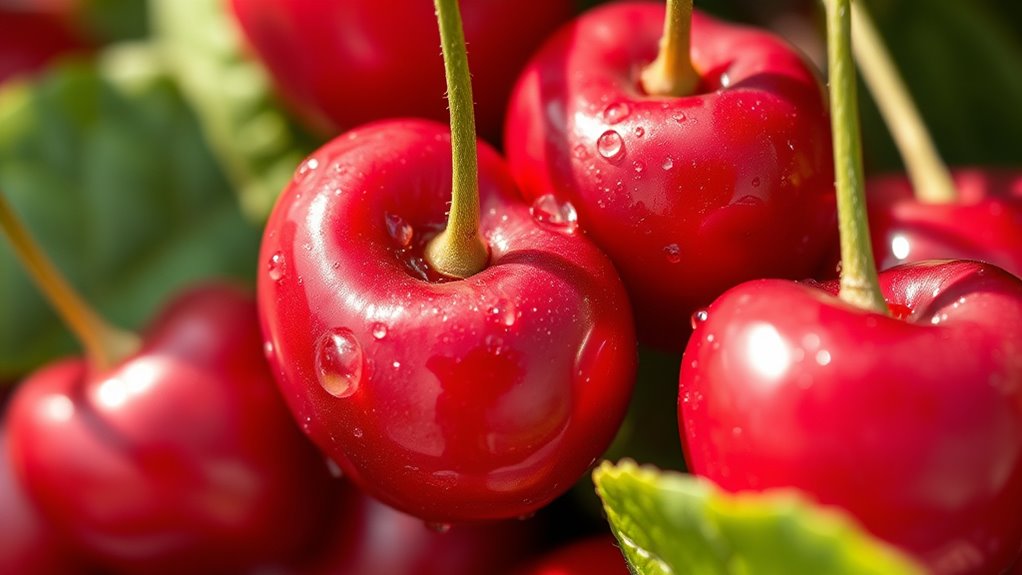
Cherries may be small, but they pack a punch with natural sugars that satisfy your sweet tooth. They also offer powerful antioxidant benefits that support your health. Incorporating cherries into your summer diet helps you enjoy both sweetness and wellness. Understanding their nutritional benefits can further enhance your dietary choices. Additionally, their sugar content provides a natural energy boost, making them an ideal snack during hot days. Utilizing home decor ideas like attractive serving dishes can make enjoying cherries even more appealing.
Natural Sugar Content
Despite their small size, cherries pack a surprisingly sweet punch thanks to their natural sugars. During fruit ripening, sugar metabolism accelerates, increasing their sweetness. This process makes cherries rich in natural sugars, which provide quick energy and flavor. The sugar content varies depending on ripeness, with fully ripe cherries having the highest levels. Here’s a quick comparison:
| Ripeness Stage | Sugar Content (g per 100g) |
|---|---|
| Immature | Low |
| Partially ripe | Moderate |
| Fully ripe | High |
Understanding how fruit ripening affects sugar levels helps you choose cherries at their sweetest. Their natural sugars are a result of efficient sugar metabolism, making them a delicious, nutrient-rich summer fruit. Additionally, Vetted options like flat iron bikes demonstrate reliable performance, which can help you enjoy outdoor activities while benefiting from the natural energy provided by fruits like cherries. Moreover, knowing the stages of ripeness can also aid in optimal harvesting and flavor enhancement. Furthermore, selecting cherries at the peak ripeness ensures you maximize their sugar content and overall flavor. To deepen your knowledge, learning about the ripening process can help you better understand how to select the best cherries for your needs.
Antioxidant Benefits
Although they are small, cherries are packed with powerful antioxidants that offer significant health benefits. These antioxidants help neutralize free radicals, reducing oxidative stress. You can get more benefits by consuming the whole fruit, including the peelings, which often contain higher antioxidant levels. Keep in mind that seasonal variations affect antioxidant content; cherries harvested at peak ripeness have more potent benefits. Here are three key antioxidants found in cherries:
- Anthocyanins, which give cherries their vibrant color and boost anti-inflammatory effects.
- Quercetin, aiding in immune support and reducing allergy symptoms.
- Melatonin, promoting better sleep and overall cellular health.
– Incorporating creative storytelling into your health journey can enhance motivation and engagement in maintaining nutritious habits.
Peaches: Juicy and Naturally Sweet
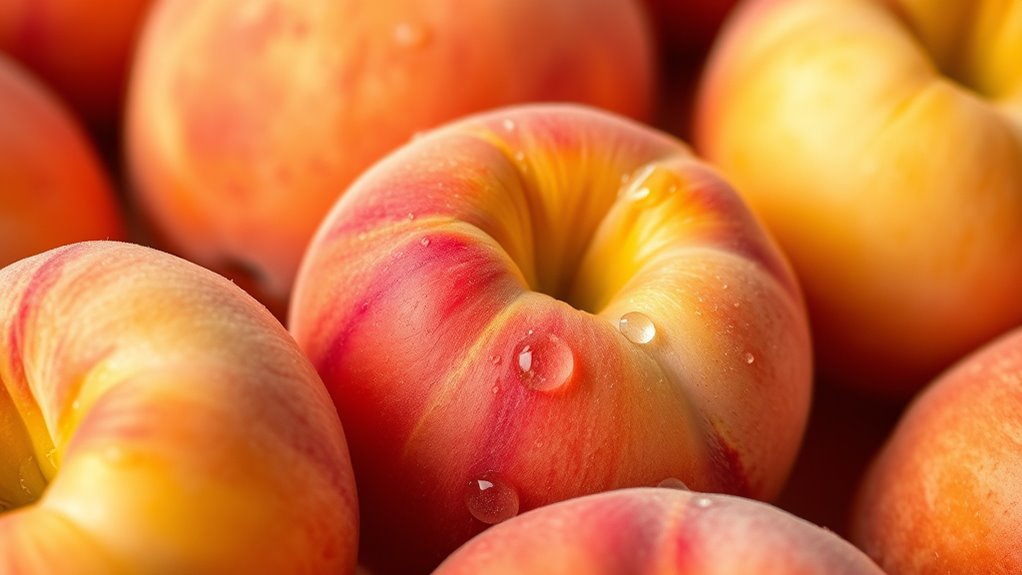
Peaches stand out as one of summer’s most deliciously sweet fruits, naturally packed with sugars that satisfy your sweet tooth without added calories. During fruit ripening, the peach’s sugars develop as starches convert, making the fruit irresistibly juicy and sweet. As you enjoy a ripe peach, you’re experiencing the result of efficient sugar absorption, where natural sugars like glucose and fructose flood the fruit’s flesh, boosting its sweetness. This process ensures that peaches deliver a balanced flavor profile, combining tartness with natural sugars. The more the fruit ripens, the more sugars accumulate, enhancing your tasting experience. So, when you bite into a perfectly ripe peach, you’re savoring a fruit that’s naturally sweetened through its ripening process, making it a healthy, satisfying summer treat.
Pineapple: Tartness Meets Natural Sugars
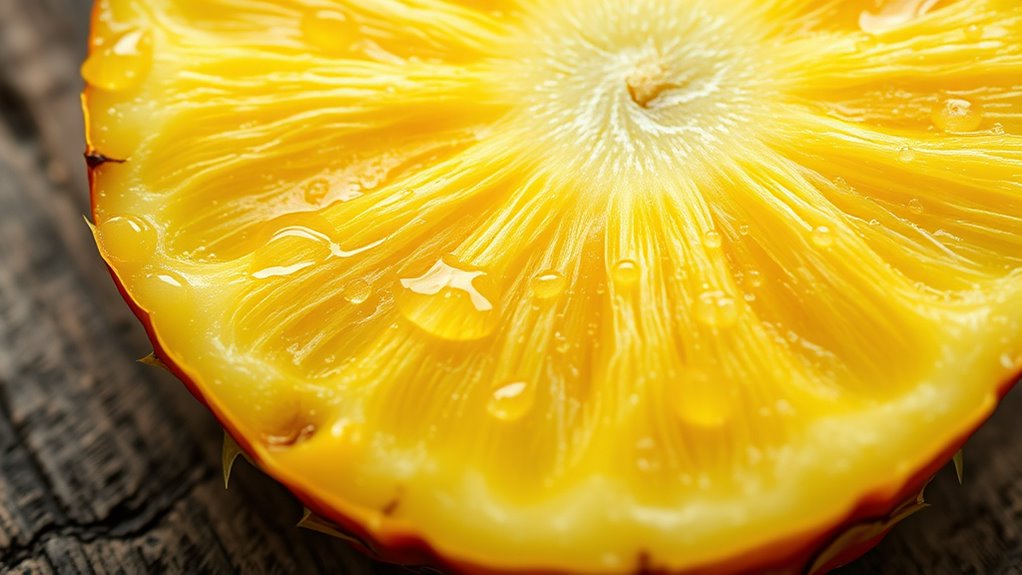
Pineapple offers a unique mix of natural sweetness and tartness that keeps your taste buds interested. Its flavor balance depends on ripeness, affecting both sweetness and acidity, making each bite distinct. When comparing sugar content, pineapples pack a flavorful punch without overwhelming, offering a invigorating, natural treat.
Pineapple’s Natural Sweetness
When you bite into a ripe pineapple, its natural sugars instantly hit your taste buds, balancing the fruit’s characteristic tartness with a delightful sweetness. This sweetness results from the pineapple’s high concentration of natural sugars, a product of careful pineapple cultivation. The sugar content varies depending on the variety and ripeness, making some pineapples noticeably sweeter than others. You can use this natural sweetness in countless ways, especially in pineapple juice recipes that highlight its vibrant flavor. To maximize flavor, select pineapples that are fully ripe and fragrant. Not only do these fruits offer a sweet punch, but they also contain enzymes like bromelain, which aid digestion. Embracing pineapple’s natural sugars enhances your summer fruit experience and adds a tropical twist to your dishes.
Tartness and Flavor Balance
While the natural sugars in pineapple provide a delightful sweetness, they’re perfectly balanced by its characteristic tartness, creating a complex flavor profile that excites the palate. During fruit ripening, the tartness gradually mellows as sugar crystallization increases, developing a sweeter, more balanced taste. This process highlights how tartness is a key element in pineapple’s flavor, offering a lively contrast to the fruit’s inherent sweetness. The interplay between tartness and sugar not only enhances the fruit’s freshness but also emphasizes its vibrancy. As the pineapple ripens, the tartness diminishes slightly, allowing the natural sugars to shine without overpowering the fruit’s signature tang. This balance makes pineapple uniquely appealing, engaging your senses with every bite.
Sugar Content Comparison
As pineapples ripen, their increasing sugar levels shape the overall flavor, balancing the tartness that initially dominates. The natural sugars in pineapple primarily come from sucrose, fructose, and glucose, which influence sugar metabolism and energy release. Knowing their sugar content helps you compare fruits effectively and align with dietary guidelines.
Consider these key points:
- Ripe pineapples contain about 10-13 grams of sugar per 100 grams, making them a naturally sweet choice.
- Their sugar levels fluctuate during ripening, impacting flavor and energy intake.
- Incorporating pineapple into your diet can satisfy sweet cravings while respecting dietary guidelines for added sugars.
Understanding sugar content helps you enjoy pineapple responsibly, balancing natural sugars with overall health goals.
Strawberries: Low-Calorie and Sweet
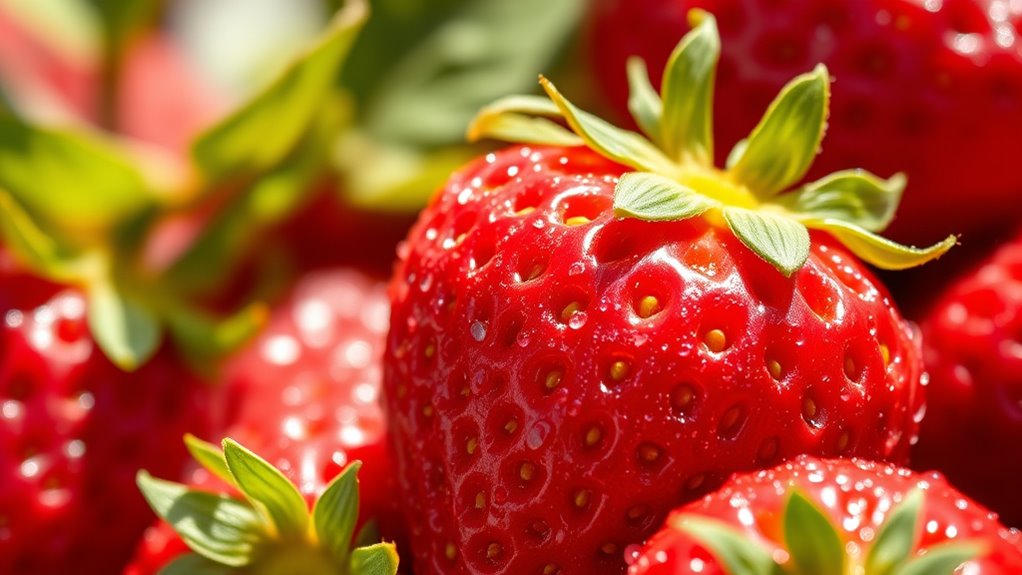
Have you ever wondered why strawberries are a popular summer fruit? Their natural sweetness and low calories make them a perfect snack. Because strawberries are highly perishable, proper fruit preservation is key to enjoying them at their best. When in season, they’re abundant and readily available, which helps keep their sugar content naturally balanced. Their seasonal availability means you get ripe, flavorful berries that haven’t traveled long distances, preserving their nutritional qualities. Strawberries contain natural sugars that satisfy your sweet tooth without excess calories. Plus, their vibrant flavor is a tribute to their freshness. Whether eaten alone or added to salads and desserts, strawberries provide a delightful, low-calorie option packed with natural sugars, making them an ideal summer fruit for health-conscious eaters.
Blueberries: Antioxidants With a Hint of Sweetness
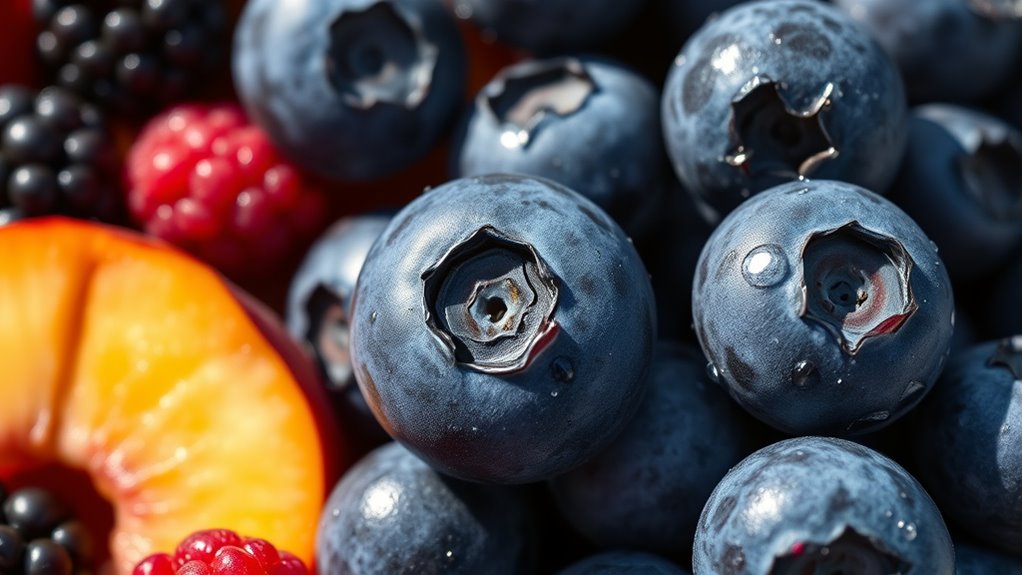
Did you know that blueberries pack a powerful punch of antioxidants along with a subtle, natural sweetness? These tiny berries are rich in blueberry antioxidants, which help fight free radicals and support your overall health. Their blueberry sweetness makes them a delicious addition to many summer dishes.
Here are 3 reasons to enjoy blueberries:
- They provide a high level of blueberry antioxidants, boosting your immune system.
- Their natural blueberry sweetness satisfies your sweet cravings without added sugars.
- They are versatile, perfect for smoothies, salads, or snacks.
Apricots: Mild and Fragrant Fruit
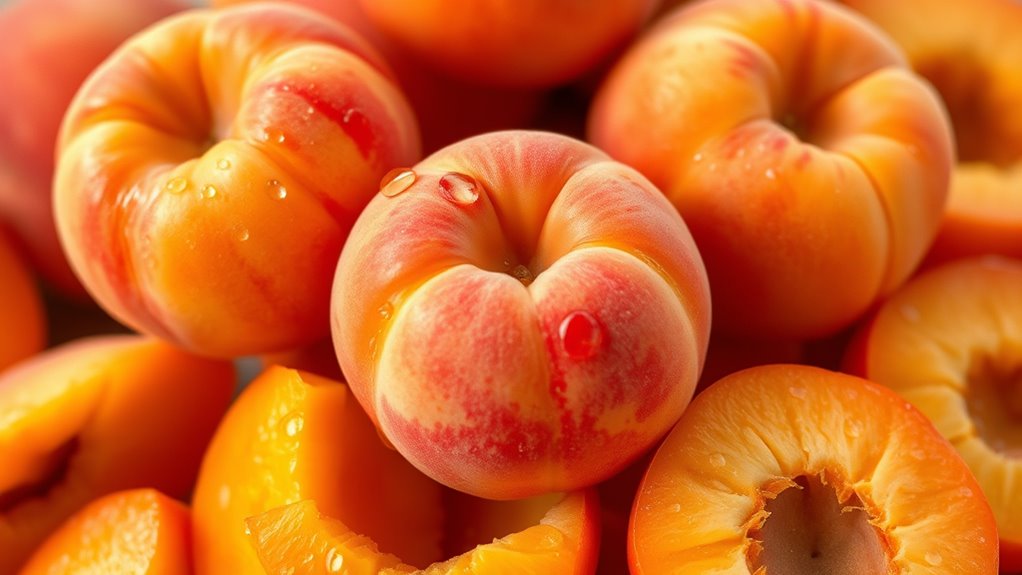
Apricots are a delightful summer fruit known for their mild, fragrant flavor and juicy texture. When you bite into one, you’ll notice the apricot aroma that immediately signals freshness and ripeness. Their subtle sweetness makes them perfect for snacking or adding to dishes without overpowering other flavors. The fruit cultivation of apricots emphasizes careful harvesting to preserve their delicate aroma and flavor profile. Because of their natural sugars, apricots provide a gentle sweetness that’s both satisfying and healthy. You can enjoy them on their own or incorporate them into desserts, salads, or jams. Their balanced flavor makes apricots a popular choice among summer fruits, especially when you want a mild, fragrant fruit with just the right touch of natural sweetness.
Plums: Tartness Balanced by Sugar

While apricots offer a gentle sweetness with their fragrant, juicy flesh, plums present a different flavor profile that balances tartness with natural sugars. During fruit ripening, the sugar metabolism in plums accelerates, reducing tartness and enhancing sweetness. This process makes plums uniquely appealing for those seeking a balanced taste. To better understand, consider these aspects:
- As plums ripen, their sugar content increases, softening their tartness.
- The balance of acidity and sugar creates a complex flavor profile.
- Natural sugars in plums are stored and processed through their sugar metabolism, influencing overall sweetness.
This balance makes plums a perfect example of how natural sugars and tartness coexist, providing a satisfying summer fruit experience.
Grapes: Concentrated Sweetness
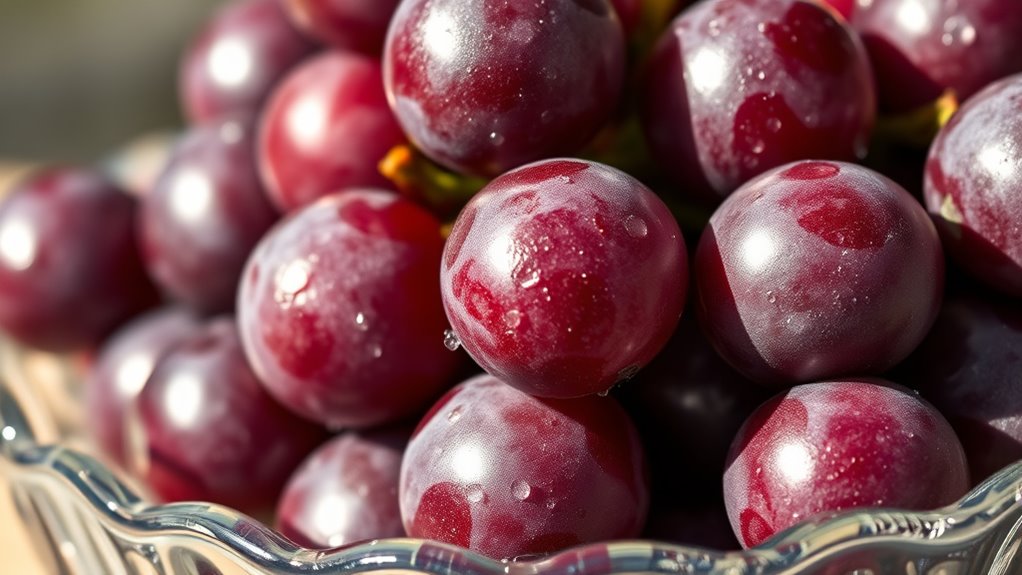
Grapes are renowned for their concentrated sweetness, which results from their high sugar density and minimal water content. This natural sugar makes grapes a delicious, energy-rich summer fruit. Because of their sweetness, grapes are often used in fruit preservation, such as making jams, jellies, or dried into raisins. Their seasonal availability peaks during late summer, so enjoying fresh grapes now maximizes their flavor and nutritional benefits. The high sugar content also helps grapes resist spoilage, extending their shelf life when stored properly. You can appreciate their natural sweetness without added sugars, especially when they’re in season. Whether eaten fresh or used in preserved forms, grapes offer a tasty, naturally sweet treat that highlights the importance of seasonal availability in maintaining fruit quality.
Frequently Asked Questions
How Do Natural Sugars in Fruits Impact Blood Sugar Levels?
Natural sugars in fruits can influence your blood sugar levels by affecting your glycemic response. When you eat fruit, the sugars are absorbed and can cause a rise in blood glucose. This prompts your body to release insulin to manage the increase. While fruits contain natural sugars, their fiber content can slow absorption, helping to moderate the insulin impact and keep your blood sugar more stable.
Which Summer Fruit Has the Highest Antioxidant Content?
Did you know that blueberries, often called a superfood, have the highest antioxidant content among summer fruits? In a fruit antioxidant comparison, they lead with anthocyanins that boost your health. Summer berry benefits include fighting inflammation and protecting your cells. If you’re choosing a fruit packed with antioxidants, blueberries are your best bet, offering both flavor and health perks. So, include more berries in your summer snacks!
Are Dried Fruits Higher in Sugar Than Fresh Options?
You might notice that dried fruit sweetness often surpasses fresh versus dried options because drying concentrates sugars. When you choose dried fruits, you’re consuming a denser sugar source, making them higher in sugar than fresh fruits. This means, if you’re watching your sugar intake, you should be mindful that dried fruits pack more sugar per serving, even though they offer similar nutrients. Always check labels to understand their sugar content better.
Do Organic Fruits Have Different Sugar Levels Compared to Conventional Ones?
Imagine choosing between two paths—organic and conventional. You’d think organic fruits, like a pure stream, are free from pesticide residues, offering a cleaner choice. While some believe organic fruits have lower sugar levels, research shows sugar content often remains similar to conventional options. Your decision hinges on your priorities: minimal pesticide residues versus potential small differences in sugar. Either way, both paths lead to delicious, nutritious summer fruits.
How Does Ripeness Affect Sugar Concentration in Summer Fruits?
When you eat ripe fruit, you’ll notice it has a higher sugar content compared to less ripe ones. Ripeness causes natural sugars to develop and concentrate as the fruit matures, making it sweeter. So, if you want more sugar, choose fruits at their peak ripeness. Keep in mind, though, that overly ripe fruit might be softer or overripe, so balance your preference for sweetness with texture and freshness.
Conclusion
As you savor summer’s fruits, think of them as nature’s candy, each bursting with unique sweetness. From watermelon’s hydrating splash to grapes’ concentrated jewel tones, they’re like a symphony of flavors dancing on your palate. Embrace these natural sugars, letting their vibrant essence fuel your days. Remember, each bite is a tiny sunbeam, sweetly nourishing your body and soul, turning ordinary moments into a juicy celebration of summer’s bounty.
Susannah expertise lies in researching and compiling evidence-based content on juicing, nutrition, and overall health. She is committed to ensuring that The Juicery World offers accurate, up-to-date, and trustworthy information to empower readers to take control of their health. Susannah’s goal is to inspire individuals to embrace juicing as a way to nourish their bodies and live their best lives.

